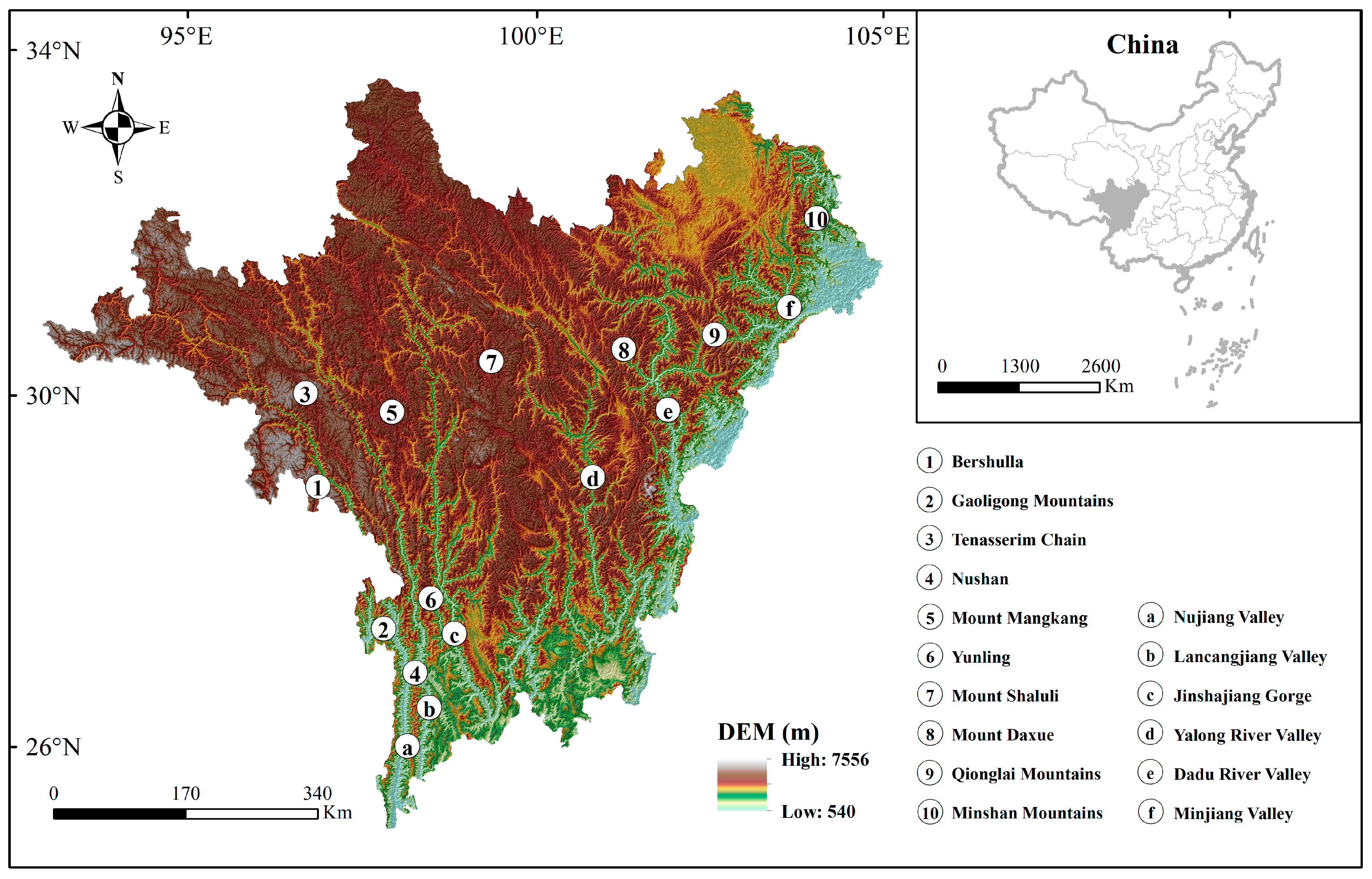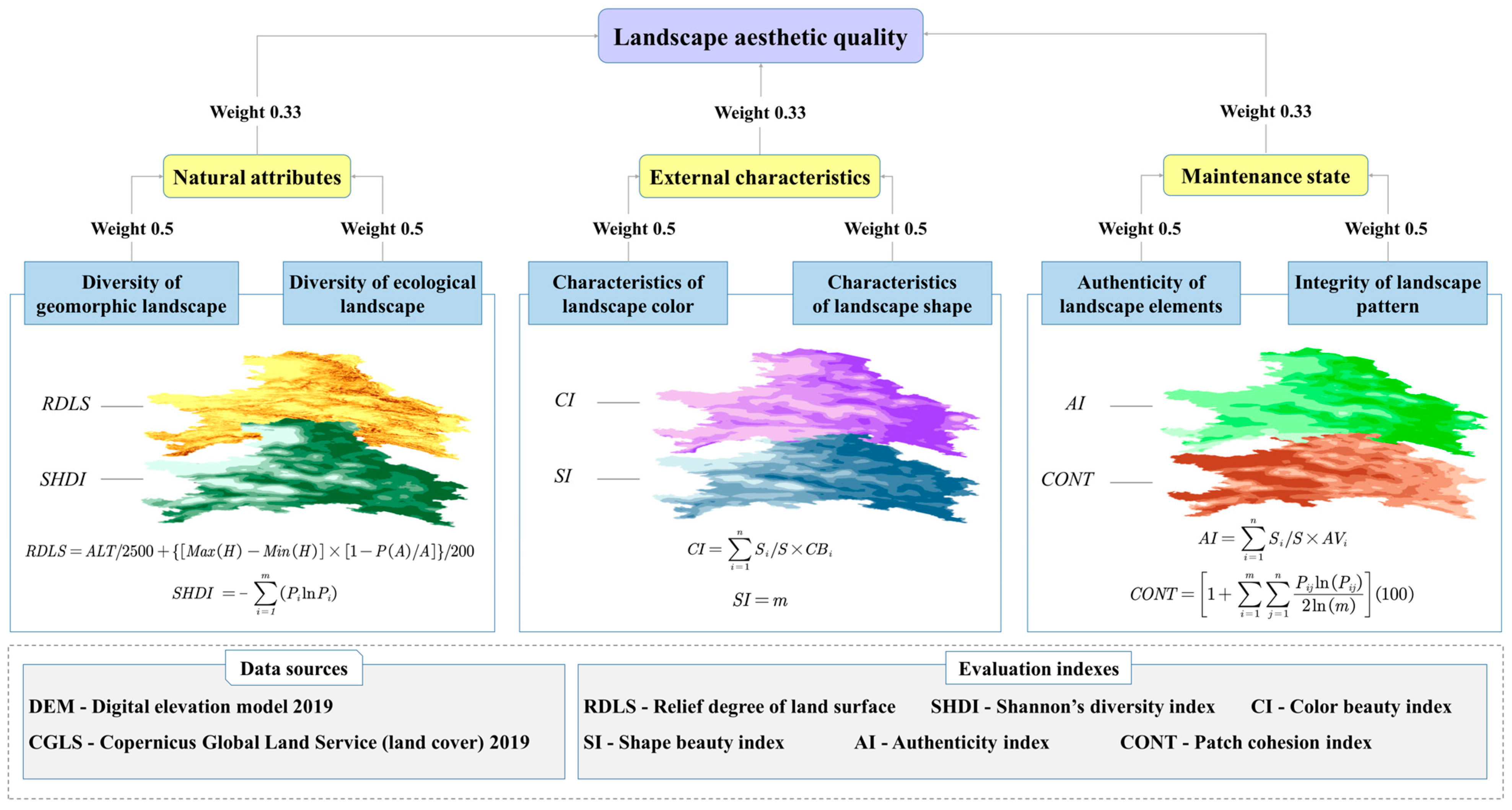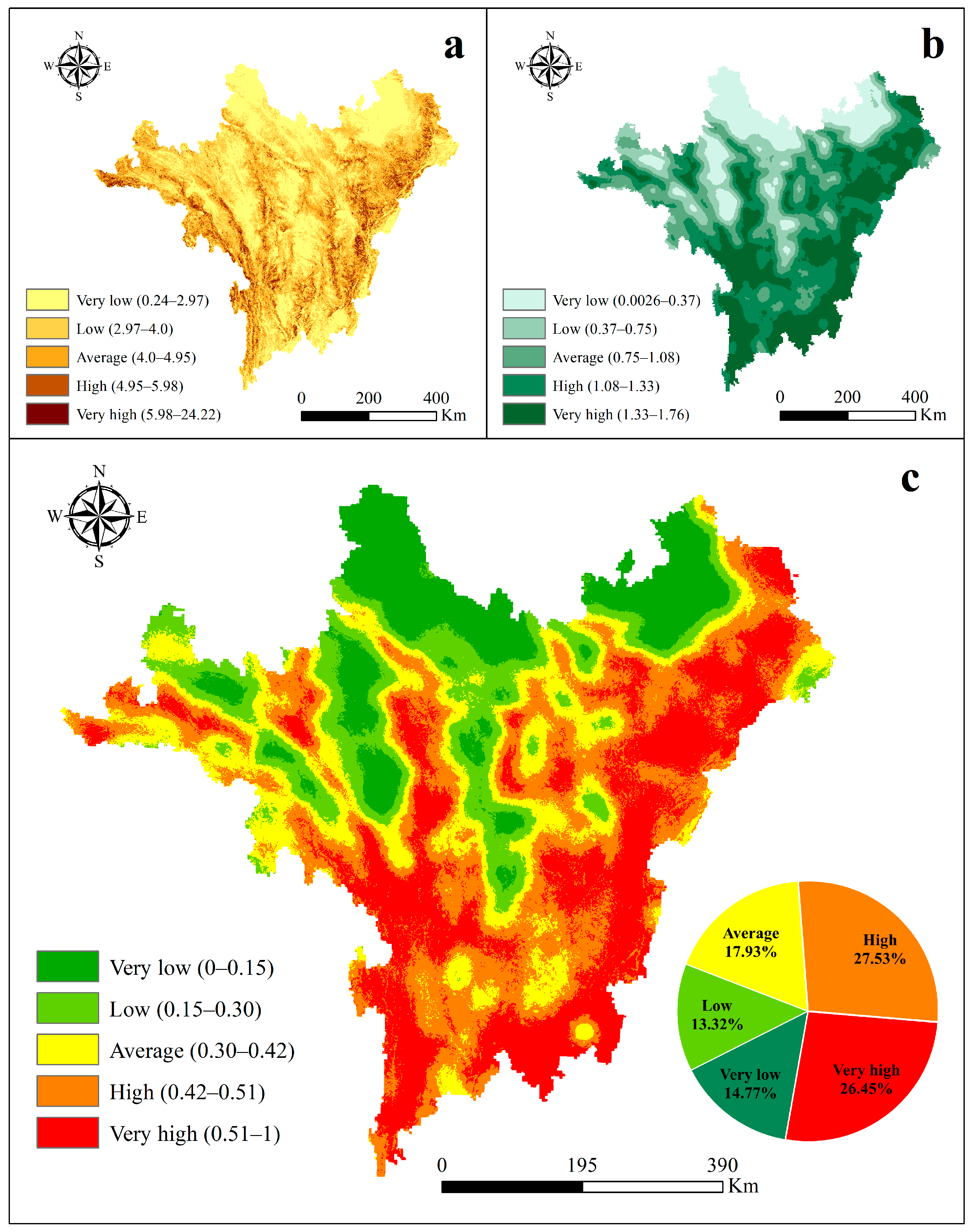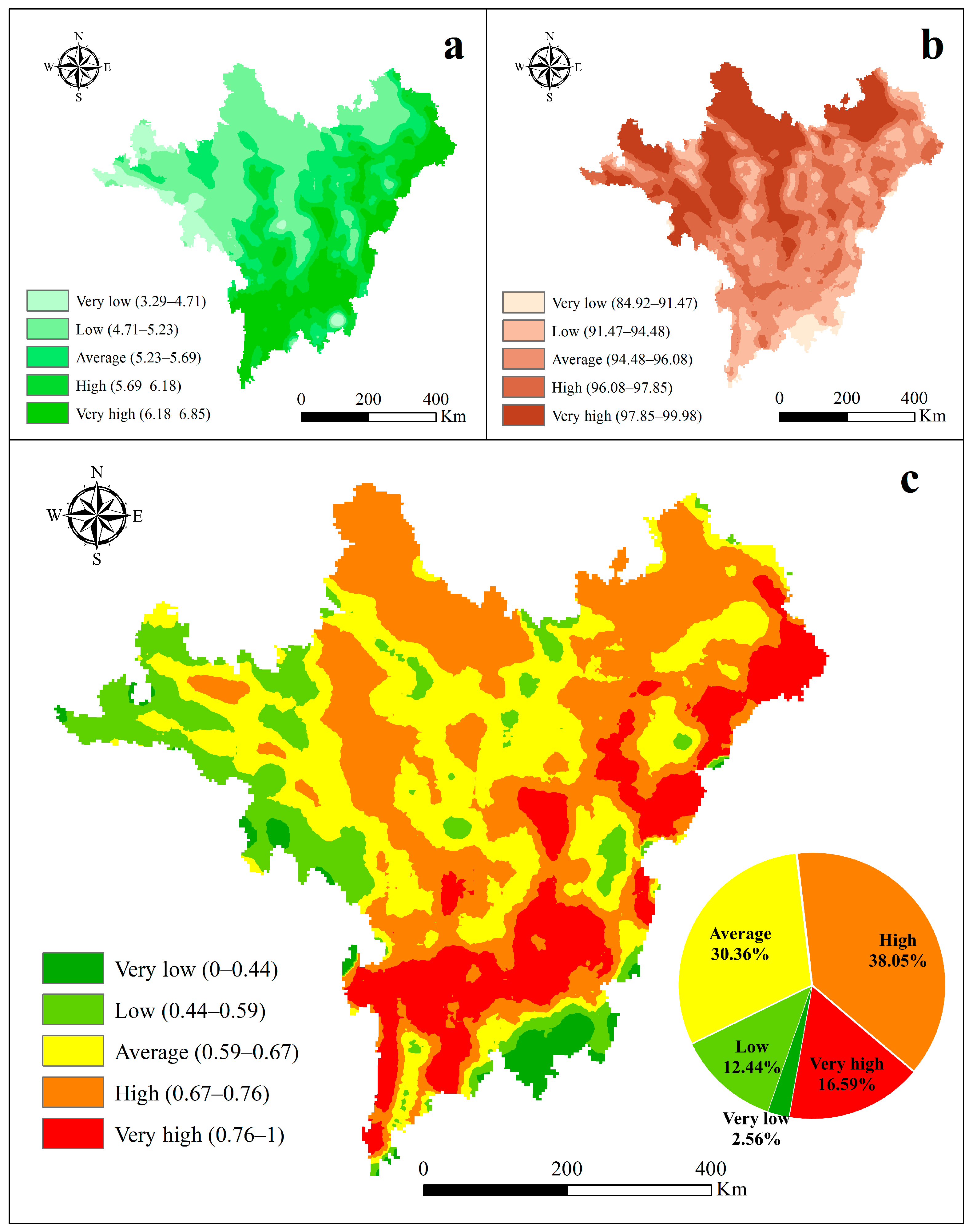Identifying Potential National Park Locations Based on Landscape Aesthetic Quality in the Hengduan Mountains, China
Abstract
1. Introduction
2. Materials and Methodology
2.1. Study Area
2.2. Data Sources and Preparation
2.3. Methodological Approach to Landscape Aesthetic Quality
2.4. Methodology for Assessing the Main Attributes of LAQ Analysis
2.4.1. Natural Attributes of LAQ
2.4.2. External Characteristics of LAQ
2.4.3. Maintenance State of LAQ
3. Results and Analysis
3.1. Attributes of LAQ
3.2. Characteristics of LAQ
3.3. Maintenance of LAQ
3.4. Comprehensive Evaluation of LAQ
4. Discussion
4.1. An Evaluation Framework of LAQ
4.2. A Contribution to the Identification of National Parks
4.3. Limitations and Future Research
5. Conclusions
Author Contributions
Funding
Data Availability Statement
Conflicts of Interest
References
- Gobster, P.H.; Nassauer, J.I.; Daniel, T.C.; Fry, G. The Shared Landscape: What Does Aesthetics Have to Do with Ecology? Landsc. Ecol. 2007, 22, 959–972. [Google Scholar] [CrossRef]
- Schirpke, U.; Tasser, E.; Tappeiner, U. Predicting Scenic Beauty of Mountain Regions. Landsc. Urban Plan. 2013, 111, 1–12. [Google Scholar] [CrossRef]
- Hermes, J.; Albert, C.; von Haaren, C. Assessing the Aesthetic Quality of Landscapes in Germany. Ecosyst. Serv. 2018, 31, 296–307. [Google Scholar] [CrossRef]
- Kalinauskas, M.; Mikša, K.; Inácio, M.; Gomes, E.; Pereira, P. Mapping and Assessment of Landscape Aesthetic Quality in Lithuania. J. Environ. Manag. 2021, 286, 112239. [Google Scholar] [CrossRef] [PubMed]
- Swanwick, C. Landscape Character Assessment: Guidance for England and Scotland; Prepared on Behalf of the Countryside Agency and Scottish Natural Heritage. 2002. Available online: https://digital.nls.uk/pubs/e-monographs/2020/216649977.23.pdf (accessed on 1 August 2024).
- Seekamp, E.; Cerveny, L.K.; McCreary, A. Institutional, Individual, and Socio-Cultural Domains of Partnerships: A Typology of USDA Forest Service Recreation Partners. Environ. Manag. 2011, 48, 615–630. [Google Scholar] [CrossRef] [PubMed]
- Frank, S.; Fürst, C.; Koschke, L.; Witt, A.; Makeschin, F. Assessment of Landscape Aesthetics—Validation of a Landscape Metrics-Based Assessment by Visual Estimation of the Scenic Beauty. Ecol. Indic. 2013, 32, 222–231. [Google Scholar] [CrossRef]
- Schüpbach, B.; Junge, X.; Lindemann-Matthies, P.; Walter, T. Seasonality, Diversity and Aesthetic Valuation of Landscape Plots: An Integrative Approach to Assess Landscape Quality on Different Scales. Land Use Policy 2016, 53, 27–35. [Google Scholar] [CrossRef]
- Kerebel, A.; Gélinas, N.; Déry, S.; Voigt, B.; Munson, A. Landscape Aesthetic Modelling Using Bayesian Networks: Conceptual Framework and Participatory Indicator Weighting. Landsc. Urban Plan. 2019, 185, 258–271. [Google Scholar] [CrossRef]
- Schirpke, U.; Zoderer, B.M.; Tappeiner, U.; Tasser, E. Effects of Past Landscape Changes on Aesthetic Landscape Values in the European Alps. Landsc. Urban Plan. 2021, 212, 104109. [Google Scholar] [CrossRef]
- Zongxing, L.; He, Y.; Wang, P.; Theakstone, W.H.; An, W.; Wang, X.; Lu, A.; Zhang, W.; Cao, W. Changes of Daily Climate Extremes in Southwestern China during 1961–2008. Glob. Planet. Chang. 2012, 80–81, 255–272. [Google Scholar] [CrossRef]
- Chang, C.-F.; Pan, Y.-S.; Sun, Y.-Y. The Tectonic Evolution of Qinghai-Tibet Plateau: A Review. In Tectonic Evolution of the Tethyan Region; Şengör, A.M.C., Ed.; Springer: Dordrecht, The Netherlands, 1989; pp. 415–476. ISBN 978-94-009-2253-2. [Google Scholar]
- Sun, D.-L.; Yao, B.-M.; Yang, G.; Sun, G.-X. Climate and Soil Properties Regulate the Vertical Heterogeneity of Minor and Trace Elements in the Alpine Topsoil of the Hengduan Mountains. Sci. Total Environ. 2023, 899, 165653. [Google Scholar] [CrossRef] [PubMed]
- Dai, E.; Wang, Y. Attribution Analysis for Water Yield Service Based on the Geographical Detector Method: A Case Study of the Hengduan Mountain Region. J. Geogr. Sci. 2020, 30, 1005–1020. [Google Scholar] [CrossRef]
- Sun, H.; Zhang, J.; Deng, T.; Boufford, D.E. Origins and Evolution of Plant Diversity in the Hengduan Mountains, China. Plant Divers 2017, 39, 161–166. [Google Scholar] [CrossRef]
- Leser, H.; Nagel, P. Landscape Diversity—A Holistic Approach. In Biodiversity: A Challenge for Development Research and Policy; Barthlott, W., Winiger, M., Biedinger, N., Eds.; Springer: Berlin/Heidelberg, Germany, 2001; pp. 129–143. ISBN 978-3-662-06071-1. [Google Scholar]
- Ren, Y.; Lü, Y.; Hu, J.; Yin, L. Geodiversity Underpins Biodiversity but the Relations Can Be Complex: Implications from Two Biodiversity Proxies. Glob. Ecol. Conserv. 2021, 31, e01830. [Google Scholar] [CrossRef]
- Feng, Z.M.; Li, W.J.; Li, P.; Xiao, C.W. Relief Degree of Land Surface and Its Geographical Meanings in the Qinghai-Tibet Plateau, China. Acta Geogr. Sin 2020, 75, 1359–1372. [Google Scholar]
- Hietala-Koivu, R.; Lankoski, J.; Tarmi, S. Loss of Biodiversity and Its Social Cost in an Agricultural Landscape. Agric. Ecosyst. Environ. 2004, 103, 75–83. [Google Scholar] [CrossRef]
- Yin, L.; Dai, E.; Zheng, D.; Wang, Y.; Ma, L.; Tong, M. What Drives the Vegetation Dynamics in the Hengduan Mountain Region, Southwest China: Climate Change or Human Activity? Ecol. Indic. 2020, 112, 106013. [Google Scholar] [CrossRef]
- Wang, Z.; Li, M.; Zhang, X.; Song, L. Modeling the Scenic Beauty of Autumnal Tree Color at the Landscape Scale: A Case Study of Purple Mountain, Nanjing, China. Urban For. Urban Green. 2020, 47, 126526. [Google Scholar] [CrossRef]
- Brielmann, A.A.; Dayan, P. A Computational Model of Aesthetic Value. Psychol. Rev. 2022, 129, 1319–1337. [Google Scholar] [CrossRef] [PubMed]
- Pott, R. Effects of Human Interference on the Landscape with Special Reference to the Role of Grazing Livestock. In Grazing and Conservation Management; WallisDeVries, M.F., Van Wieren, S.E., Bakker, J.P., Eds.; Conservation Biology Series; Springer: Dordrecht, The Netherlands, 1998; pp. 107–134. ISBN 978-94-011-4391-2. [Google Scholar]
- Walz, U.; Stein, C. Indicators of Hemeroby for the Monitoring of Landscapes in Germany. J. Nat. Conserv. 2014, 22, 279–289. [Google Scholar] [CrossRef]
- Sowifska-fwierkosz, B. Index of Landscape Disharmony (ILDH) as a New Tool Combining the Aesthetic and Ecological Approach to Landscape Assessment. Ecol. Indic. 2016, 70, 166–180. [Google Scholar] [CrossRef]
- Chang Chien, Y.-M.; Carver, S.; Comber, A. Using Geographically Weighted Models to Explore How Crowdsourced Landscape Perceptions Relate to Landscape Physical Characteristics. Landsc. Urban Plan. 2020, 203, 103904. [Google Scholar] [CrossRef]
- Zou, L.; Wang, J.; Bai, M. Assessing Spatial–Temporal Heterogeneity of China’s Landscape Fragmentation in 1980–2020. Ecol. Indic. 2022, 136, 108654. [Google Scholar] [CrossRef]
- Yao, Y.; Zhang, B.; Han, F.; Pang, Y. Diversity and Geographical Pattern of Altitudinal Belts in the Hengduan Mountains in China. J. Mt. Sci. 2010, 7, 123–132. [Google Scholar] [CrossRef]
- Wang, J.; Liang, S.; Shi, P. Topography and Landforms. In The Geography of Contemporary China; Wang, J., Liang, S., Shi, P., Eds.; Springer International Publishing: Cham, Switzerland, 2022; pp. 63–84. ISBN 978-3-031-04158-7. [Google Scholar]
- Du, A.; Xu, W.; Xiao, Y.; Cui, T.; Song, T.; Ouyang, Z. Evaluation of Prioritized Natural Landscape Conservation Areas for National Park Planning in China. Sustainability 2020, 12, 1840. [Google Scholar] [CrossRef]
- Li, J.; Wang, W.; Axmacher, J.C.; Zhang, Y.; Zhu, Y. Streamlining China’s Protected Areas. Science 2016, 351, 1160. [Google Scholar] [CrossRef] [PubMed]
- Huang, Q.; Fei, Y.; Yang, H.; Gu, X.; Songer, M. Giant Panda National Park, a Step towards Streamlining Protected Areas and Cohesive Conservation Management in China. Glob. Ecol. Conserv. 2020, 22, e00947. [Google Scholar] [CrossRef]
- Wang, L.; Pan, Y.; Cao, Y.; Li, B.; Wang, Q.; Wang, B.; Pang, W.; Zhang, J.; Zhu, Z.; Deng, G. Detecting Early Signs of Environmental Degradation in Protected Areas: An Example of Jiuzhaigou Nature Reserve, China. Ecol. Indic. 2018, 91, 287–298. [Google Scholar] [CrossRef]
- Qiao, J.; Jia, G.; Zhou, H.; Gong, L.; Jiang, Y.; Xiao, N.; Gao, X.; Wen, A.; Wang, J. Mammal and Bird Diversity Recorded with Camera Traps in Gongga Mountain National Nature Reserve, Sichuan, China. Biodivers. Sci. 2022, 30, 20395. [Google Scholar] [CrossRef]
- Chen, D.; Zhong, L.; Fan, J.; Yu, H.; Yang, D.; Zeng, Y. Evaluation and Structural Analysis of the Functions of the Tibetan Plateau National Park Cluster. J. Geogr. Sci. 2022, 32, 957–980. [Google Scholar] [CrossRef]
- Zhou, D.Q.; Edward Grumbine, R. National Parks in China: Experiments with Protecting Nature and Human Livelihoods in Yunnan Province, Peoples’ Republic of China (PRC). Biol. Conserv. 2011, 144, 1314–1321. [Google Scholar] [CrossRef]
- Yang, Y.; Shen, Z.; Han, J.; Zhongyong, C. Plant Diversity along the Eastern and Western Slopes of Baima Snow Mountain, China. Forests 2016, 7, 89. [Google Scholar] [CrossRef]
- Li, Q.; Li, X.-Y.; Hu, W.-Q.; Song, W.-Y.; He, S.-W.; Wang, H.-J.; Hu, Z.-C.; Li, M.-C.; Onditi, K.O.; Chen, Z.-Z.; et al. The Mammals of Gaoligong Mountain in China: Diversity, Distribution, and Conservation. Zool. Res. Divers. Conserv. 2024, 1, 3–19. [Google Scholar] [CrossRef]









| Landscape Type | CBi |
|---|---|
| Snow and ice; Permanent water bodies; Closed forest, deciduous broad leaf; Closed forest, mixed; Open forest, deciduous broad leaf; Open forest, mixed | 5 |
| Shrubs | 4 |
| Closed forest, evergreen needle leaf; Closed forest, evergreen broad leaf; Open forest, evergreen needle leaf; Open forest, evergreen broad leaf | 3 |
| Herbaceous vegetation; Herbaceous wetland; Moss and lichen; Closed forest, unknown; Open forest, unknown | 2 |
| Cultivated and managed vegetation/agriculture (cropland); Urban/built up; Bare/sparse vegetation | 1 |
| Landscape Type | AVi |
|---|---|
| Closed forest, evergreen needle leaf; Closed forest, evergreen broad leaf; Closed forest, deciduous broad leaf; Closed forest, mixed; Closed forest, unknown | 7 |
| Open forest, evergreen needle leaf; Open forest, evergreen broad leaf; Open forest, deciduous broad leaf; Open forest, mixed; Open forest, unknown | 6 |
| Shrubs; Herbaceous vegetation; Snow and ice; Herbaceous wetland; Moss and lichen | 5 |
| Permanent water bodies | 4 |
| Bare/sparse vegetation | 3 |
| Cultivated and managed vegetation/agriculture (cropland) | 2 |
| Urban/built up | 1 |
Disclaimer/Publisher’s Note: The statements, opinions and data contained in all publications are solely those of the individual author(s) and contributor(s) and not of MDPI and/or the editor(s). MDPI and/or the editor(s) disclaim responsibility for any injury to people or property resulting from any ideas, methods, instructions or products referred to in the content. |
© 2024 by the authors. Licensee MDPI, Basel, Switzerland. This article is an open access article distributed under the terms and conditions of the Creative Commons Attribution (CC BY) license (https://creativecommons.org/licenses/by/4.0/).
Share and Cite
Duan, S.; Yang, Z.; Han, F. Identifying Potential National Park Locations Based on Landscape Aesthetic Quality in the Hengduan Mountains, China. Land 2024, 13, 1278. https://doi.org/10.3390/land13081278
Duan S, Yang Z, Han F. Identifying Potential National Park Locations Based on Landscape Aesthetic Quality in the Hengduan Mountains, China. Land. 2024; 13(8):1278. https://doi.org/10.3390/land13081278
Chicago/Turabian StyleDuan, Shuaifei, Zhaoping Yang, and Fang Han. 2024. "Identifying Potential National Park Locations Based on Landscape Aesthetic Quality in the Hengduan Mountains, China" Land 13, no. 8: 1278. https://doi.org/10.3390/land13081278
APA StyleDuan, S., Yang, Z., & Han, F. (2024). Identifying Potential National Park Locations Based on Landscape Aesthetic Quality in the Hengduan Mountains, China. Land, 13(8), 1278. https://doi.org/10.3390/land13081278





